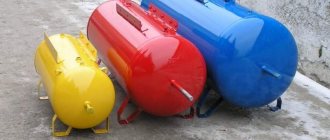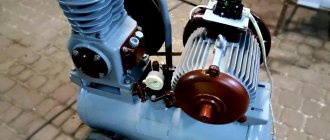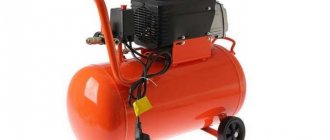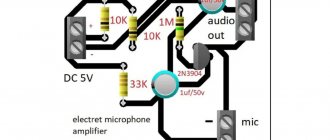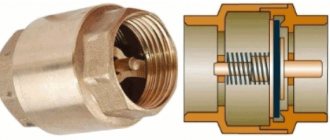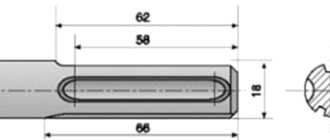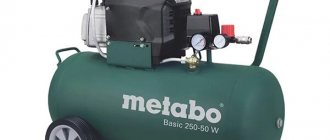What will you learn from this article?
:
- What is an air receiver and what is it for?
- When is it necessary to drain condensate from the receiver?
- Options for connecting a compressor to a receiver
- What pressure should be in the receiver?
The diagram of a standard working pneumatic network is as follows (Figure 1):
Atmospheric air enters the compressor (1), where it is compressed. Next, the compressed air passes through a cyclone separator (2), where oil and water vapor are removed from it. Then the working medium enters the receiver (3), passes through filters (4) and a dryer (5) and reaches the consumer.
And if in most cases the purpose of separators, filters and desiccant is clear to users, then many questions arise about the connected receiver. Today we will look at some of them.
Why do you need a receiver in a compressor?
The receiver included in the supercharger provides a solution to several complex problems, in particular:
- Guarantees stable pressure of the working medium transported to consumers.
- Provides gas transportation at a time when the compressor begins to operate intermittently, or an additional consumer is connected to the air supply system.
- Cleaning the compressed air mixture from accumulated moisture.
- The accumulation of gas in this container leads to a decrease in vibrations in the compressor. This in turn reduces the level of force loads affecting the foundation.
- To carry out work that involves producing a large amount of gas normally, the installed vessel may not be enough, so instead of purchasing and installing a stronger compressor, an additional tank is installed on the old compressor.
- The receiver ensures that the compressor is turned on at a certain frequency, and this leads to a decrease in electrical energy consumption.
In essence, a compressor receiver is a container of a certain size. For mobile compressors, containers with a volume of 50 to 100 liters are used. For stationary units, receivers with a volume of up to 1000 liters are used.
Filters are installed on them, which purify the gas from moisture; in addition, the design of the receiver includes condensate drains and shut-off valves. It is used to connect the compressor to consumers.
For the manufacture of receivers, corrosion-resistant steels 10HSND or 16GA2F are used, meanwhile, in rare cases, polymers or high-strength elastomers are used for low-power units.
Manufacturers produce two types of containers - horizontal and vertical. The first version is used for mobile type compressors, the second version is used for stationary compressors.
Each of the versions has its own advantages and disadvantages. For example, in a vertical design it is easier to drain water, while horizontal ones are more compact in size and require shorter pipelines.
Schematic diagram of operation
In general, the operation of the receiver can be described as follows.
- Using the inlet pipe, air from the compressor is supplied to the tank, where it accumulates until the required operating pressure is reached.
- During the accumulation process, the air cools, as a result of which condensation accumulates at the bottom of the tank - thus, additional drying of the working environment is carried out, which helps reduce the effect of corrosion on all elements of the system. The condensate that collects at the bottom of the tank is drained through a special tap.
- When the required pressure is reached, compressed air enters the outlet pipeline and is supplied through it to the connected pneumatic tool.
On a note! In practice, the operation of the receiver is controlled by a reducer, which regulates the pressure of the air leaving the tank.
How to choose the optimal receiver parameters
Like any technical product, the receiver has a number of technical parameters. Among them are:
- Volume, l.
- Humidity.
- Operating parameters, that is, limit values of humidity and temperature.
- Characteristics of the installation location of the compressor unit. It must be installed away from sources of heat, fire and explosive substances. The presence of foreign particles in the air is undesirable, for example, in procurement areas.
Safety rules state that it is unacceptable to use receivers that have not passed the appropriate test, on the surface of which there are mechanical damage in the form of cracks and traces of corrosion.
The selection of a receiver is carried out on the basis of a fairly simple calculation:
- The required flow rate of the air mixture, the duration of the flow rate, and the maximum operating pressure are determined.
- Using special calculation tables, they exist both in paper form and as Internet applications. For example, with a productivity of 0.1 cubic meters per minute, a maximum load duration of 5 minutes and within a pressure range of 3/4 (min/max), the volume of the receiver will be about 500 liters.
This method of calculation is focused on the time required to completely empty the container.
There is another technique based on the ratio of the volume of the vessel and the power of the air compressor. In practice, the following ratios are used:
- Power 5 kW, volume max – 100 l.
- Power 10 kW, volume max – 300 l.
- Power 20 kW, volume max - 550 l.
There are also experimental dependencies, for example, the volume of the receiver cannot be less than the amount of air that the compressor can produce for 8 seconds of operation. For example, the flow rate is 400 liters per minute, respectively, the volume of the poppy must be at least 53 liters.
Here you can select and buy air receivers for compressors.
Basic criteria for choosing air collectors
After reading this article, you learned why you need a receiver in a compressor, what types of tanks there are, and how to install two or more storage tanks. In conclusion, we suggest that you study the main parameters that require attention when purchasing equipment.
- Volume. This figure varies from 5 liters (for household models) to 1000 or more liters (for industrial units). When choosing, you should adhere to the rule: the more powerful the compressor, the larger the receiver. On average, its volume should be about 30-50% of the unit’s productivity.
- Pressure. For use in conjunction with household tools, a receiver designed to store air under pressure up to 10 bar is usually sufficient. For commercial use in small businesses, models that can withstand up to 16 bar are suitable.
- Bandwidth. This parameter determines how much air (in liters) the receiver can pass through in one minute. The higher the demand for compressed gas, the greater the throughput of the air collector must be.
Based on these selection criteria, you can select equipment that is optimally suited for the given operating conditions.
When starting this article, we planned to answer the common question about why a receiver is needed in a compressor. But we couldn’t help but touch on the topic of choosing and using compressed air storage devices. We hope that our tips will be useful. If you still have questions, we invite you to take advantage of professional help in selecting a compressor receiver. To consult with a specialist from Energoprof Group of Companies, contact us at the toll-free phone number listed on the website.
Do-it-yourself additional receiver for a compressor
Some work performed in a home workshop or garage requires compressed air. And a situation may arise when a household compressor cannot cope with the task. In this case, the situation can be resolved by installing an auxiliary receiver on the existing unit. This device can either be purchased at a specialized store, for example, car spare parts. There you can buy a receiver for the KAMAZ pneumatic system, or make it yourself.
Most of the receivers offered are made for a specific model and are distinguished by a high price. Depending on the planned size of the DIY container, you can use either a propane cylinder or a fire extinguisher body.
Advantages of dry storage tanks
The ideal ratio of wet and dry air in the air system is 1/3 wet air and 2/3 dry air. Without a dry storage tank, the dehumidifier is at risk of accumulating too much condensation during periods of high load as the system attempts to draw in more air than the dehumidifier can produce. If the dryer is overloaded, water may enter the compressed air system. The only example where a dry storage tank is not necessary is in systems with constant air flow.
The procedure for making a homemade receiver
The sequence of manufacturing an additional vessel looks approximately as follows.
- Cleaning an old vessel from gas residues. To do this, you will need to clean it of gas residues. The inlet valve is removed, while using an electric tool, for example, an angle grinder, gas residues may remain in the housing.
- The vessel is filled with water and allowed to stand for 24 hours. Then it is drained and the internal cavity is cleaned of dirt.
- After this, splitters under the sleeves are welded into the cylinder, but it is also permissible to install threaded fittings; to increase the tightness when installing plugs, it is necessary to install sealing gaskets.
- A homemade receiver must be painted with weather-resistant paint.
- A condensate drain is installed in the assembled and painted maneuver - its place is at the lowest point of the tank, and a pressure gauge is installed in the upper part. The brand of condensate drain must be consistent with the compressor capacity and thread sizes. The cost of such a device ranges from 2500 to 3000 rubles.
When operating a condensate trap, we must not forget that its installation on an auxiliary gas storage tank is mandatory. Before switching on the operating load, it is necessary to check the condition of the electric drive to ensure that it can be operated with an auxiliary gas container.
To do this check, you need to turn on the compressor and use a flow meter to check the pressure surge during long-term operation (about 20 minutes).
If the minimum pressure corresponds to the declared characteristics of the supercharger, then operation of the assembled structure is quite acceptable. If the pressure drop is below the permissible level, then the use of this equipment is in question and it is undesirable to use it.
Classification
In addition to the fact that there are mobile and stationary receivers, experts note other design features of air collectors that allow them to be considered different types of products. So, there are horizontally and vertically oriented containers.
At the same time, horizontal receivers are more compact and make it possible to economically accommodate a pump, electric motor and other auxiliary equipment. A characteristic feature of this arrangement is the minimum length of connecting pipelines. Thanks to these features, horizontal receivers are widely used both in household compressors and in automotive pneumatic systems.
Operation and Maintenance
Day-to-day maintenance of the air collector is carried out by company employees. If the design of the unit does not provide for automatic blowing, then it is performed 2 times per shift. The equipment is cleaned from oil contaminants every 5000 hours. Anti-corrosion agents are used for this. A sulfonal solution (3%) is recommended. The use of flammable substances is prohibited. After cleaning, purging is performed for at least 30 minutes.
According to the instructions on labor protection when operating air collectors, employees who have reached the age of 18, who have no medical contraindications, who have been trained and certified in accordance with the rules established by the State Education Authority, are allowed to work. Private training is not permitted.
Special requirements
A fitting is provided at the bottom of the receiver to drain condensate. The moisture accumulated in the container must be drained in a timely manner, otherwise it may get into other elements of the pneumatic system.
To ensure safe operation, a safety valve must be installed. Thanks to it, at any pressure in the compressed air line, the tightness of the receiver will not be compromised. In addition, the presence of a safety valve in the system makes it possible not to turn off the compressor when the design pressure is reached inside the receiver.
Anti-corrosion protection is of great importance in the manufacture of air collectors. Moreover, the coating is applied to the outside and inside of all parts of the container. For this purpose, zinc-containing paints, various galvanizing methods and powder coating are used.
Tags
Compressors Screw Compressors Piston Compressors Mobile Compressors Scroll Compressors Explosion Proof Compressors Compressor EquipmentAir Compressor Screw Compressors Piston Compressors Compressed Air SupplyThis Compressed Gas
oil-freeremezatoolcopcoarticlesoperationquestionpartsvalvepurposeselectionmachinescompanyseriesapplicationperformancecylindermodelmainparameterspneumaticspare partshandsfireplacebackkwrefugeeapparatusscrewbargasabacsourcegeneratorsproductsatlasmachines
Installation and safe use rules
The receiver is installed in the production room if it is stationary. For reliable fastening to the base, a solid foundation is built. When fixing the paws to the concrete, rubber shock absorbers are used. The drive must be secured securely to prevent it from tipping over. It is unacceptable to store substances that can ignite in the same room. It is necessary to ensure free access to the tank for maintenance and inspection.
Before installation, you should check the presence of documentation , whether a plate with data on its characteristics is installed on the receiver. Make sure that the emergency valve and pressure gauge, pipes and shut-off devices are available and installed correctly. The drive must not have any mechanical damage.
